'Bearing away for speed!' Bellows the skipper. My ankles are submerged in rushing seawater as I pin myself between the fife rail and a deck locker. I lift the camera to my eye and shoot the guy on the foresail winch who is desperately trying to get his sail perfect. There are few moments to relax here, everyone is on a knife edge, each muscle ready to move.

With less than a fortnight until the Antigua Classic Yacht Regatta, yacht crews all over the Caribbean are gearing themselves up for the race of the year and I imagine the crew of Coral of Cowes will be no different. Antigua may be the name on everyone's lips when it comes to Caribbean, even world, regattas - but my initiation to racing in the Classics class came earlier in the year, on board Coral in the 2015 Grenada Sailing Week.
Yacht racing has become hi-tech racing demons flying hulls, emblazoned with sponsor stickers like Volvo and Hugo Boss, and challenging speed records left, right and centre. The Volvo Ocean Race, the Vendee Globe, the Route de Rhum and the America's Cup all feature construction materials that most of us have never heard of and break sails to the tune of hundreds of thousands. The yacht racing that hits our front pages may be awe inspiring with its ever changing technological goal posts but that doesn't mean something else isn't going on behind the scenes; something beautiful.
I never wanted to race. Until two years ago, I never wanted to sail. By the time I was invited on board Coral of Cowes to race in January 2015 though, I'd sailed over five thousand miles as half of a two-person crew. Nevertheless, the idea of racing scared me. Monohulls go faster when they are heeled over as speed is a function of their waterline length and that is longer when they are heeled. The problem is, I don't like sailing really heeled over...it makes me think the boat might, y'know, fall over.
'You can swim can't you?' Asked Adrian, a crew member on another yacht. 'Well, yes,' I replied. 'Then what's the problem?' - he had a point. When I first looked around Coral on the day before the regatta started, I asked 20 year old deckhand Charlie about the angle of heel when racing. He looked thoughtful. 'Not a scary amount,' he said. I would've felt more relieved if this hadn't come from someone who planned on rowing across the Atlantic in 2016. His definition of 'scary' probably differed from mine.

The owner and skipper of Coral, Richard Oswald, is a difficult man to say to no however and so on the 30th January I found myself stepping aboard his magnificent 85ft gaff-rigged schooner. With a permanent crew of five, this 1902 British yacht must've sat lower in the water with her additional racing crew of twelve and there was already a busy atmosphere by the time I'd arrived.
Convinced I wouldn't know the topsail from a top hat, I convinced Richard that I would be far better suited to ship's photographer than to any line handling. As photographer then, I had two jobs; firstly, take photographs and secondly, stay out of everyone's way. It suited me, I could hide my fear with a camera.
The first day's racing was intense in a way I couldn't have expected. Richard single-handedly directed a crew of seventeen, mostly volunteers unused to the boat, around an eleven mile course off Grenada's Caribbean coastline. Coral's seventy six tonnes rarely lumbered, rather danced, as she was built to do, through the flat water and spritely wind. As she heeled over, and over...and over, it didn't feel as though I were standing on a precipice- it felt like the most natural thing in the world. 'Don't worry,' said Richard, his eyes alive with the rush, 'she's designed to do this.'

And she was. That's the thing about classic yachts, they weren't designed just to fast, or to be palatial to live on - they were designed to flow, to live, to sail. An enormous gaff rigged schooner like Coral may look luxurious as she minces up the Solent on a sunny summer's day but give her a starting gun and an opponent and she's ferocious. She sails like a lady, if that lady were Catherine the Great.
We raced over three days against several other Classics from the turn of the century. With so many people on board and so much life and history seeping out of every panel, it was an addictive experience. These Classics aren't fragile and aged, anything but. They charge the course as though it's fun hour at the swimming pool and push their solid wooden bodies to the limit. This is no flimsy one tonne racing yacht, she's built to last.
I spent the races practically crawling about the deck taking photographs of the crew in action. There is something so utterly photogenic about a race on board a classic yacht and by the end of the second day my camera had been dead for an hour. I can see why the record breaking multihulls of today are stunning, but surely there's something even more incredible about a 113 year old yacht still kicking ass in the Caribbean?

So after taking my place on the deck on Coral of Cowes in the January 2015 Grenada Sailing Week and experiencing the rush of water at my feet as we pounded to windward with the side decks under water I can say yes, I can swim, but with a ship like this, who needs to?
Coral of Cowes went on to win the Classics Class in Grenada Sailing Week and will be racing in the forthcoming Antigua Classic Yacht Regatta when her crew will be joined by charter guests. She is owned and skippered by Richard Oswald and will grace UK waters once more this summer.